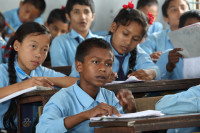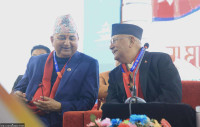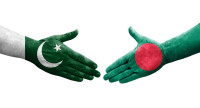Opinion
If the BJP emerges victorious
Not since Indira Gandhi would India see such a concentration of power in the hands of a single individual.
Kashif Islam
Extending over several phases during the past month-and-half, the great Indian election has finally drawn to a close. And with it went the rallies, the promises, the attacks, and the unending media coverage. Life can return to normal, even on television where serious poll pundits will now discuss the prospects of the various parties. No-one will be more relieved than the cadres and leaders of the major parties after months of campaigning, back to back rallies and news conferences. They will have some respite, at least until the results are declared on May 23, 2019.
Given the scale of the undertaking, there were relatively few untoward incidents. Voters failed to turn up at several booths in Maoist-affected areas in central India. In Tamil Nadu, the election commission had to order repolling at a constituency. Kashmir, as usual, saw marginal turnout. The one exception to the general trend was West Bengal, which reported widespread incidents of violence and intimidation right through the elections with pitched battles between supporters of the BJP and the Trinamool Congress (TMC).
As would be expected, given the high stakes and the charged atmosphere, there were numerous complaints of violations of the model code of conduct. No party, however, upheld the high levels of conduct it expected everyone else to behave. The prime minister himself was involved in six of these, among others, for urging citizens to come out to vote in the name of the victims of the Pulwama attack. While a few mid-level leaders were temporarily barred from campaigning, the election commission let off the prime minister himself.
As has now become the norm, the elections were fought not as much through people to people contact and the old channels of pamphlets, posters and newspapers, as through the mass media, especially television and social media. With an estimated 600 million internet users and an even higher number of cable TV viewership, the impact of a rally or a public statement was no more limited to the time and place of its occurrence.
The previous general election had shown how effective media use could be harnessed to turn around public opinion. It is a moot question whether the massive and largely favourable media coverage abetted the Modi-wave in 2014 or whether it was merely a reflection of an existing dynamic. Consequently, the communication and media budgets of all the major parties have gone up, but the asymmetry in media coverage and the reach between the BJP and the opposition parties appear to still be a reality.
Such spending obviously implies deep pockets and the role of money power in elections. While there are limits on spending by individual candidates, spending by parties is outside the purview of the election commission. As estimated by the New Delhi-based Centre for Media Studies, the total expenditure incurred in the elections is around INR500 billion, out of proportions to the declared income of INR130 million of all the major national parties combined. Much of the funding is opaque. Electoral bonds allowing anonymous contribution by individuals and organisations were introduced by the government in 2017. Significantly, the BJP also remains the biggest beneficiary of the scheme.
A few generalisations can be made about the outcome. The ruling party’s chances depend to a large extent on the voting outcome in North and West India. This was the region that contributed the bulk of the 282 seats the BJP won in the last elections, leading to an outright majority in the 543-member lower house. The BJP would obviously be hoping for a repeat of 2014, with a clean sweep giving it a majority on its own.
However, unlike the last time around, a few things have changed. For one, the opposition is better prepared. Although distrust of the Indian National Congress by the regional parties failed to materialise a unified opposition front, the opposition parties have managed to form alliances, such as in Uttar Pradesh and Bihar. Then, there is an anti-incumbency factor playing out in central and western India, where the Congress would be hoping to repeat last year’s performance—when it wrested power back from the BJP in three of these states and improved its tally in Gujarat.
The BJP will be looking to compensate for any seats lost in the Hindi heartland (North India) and West India by winning seats elsewhere. It is unlikely to improve its tally in the south; on the other hand, the party will have its eyes set on the eastern states of West Bengal and Odisha. Over the past few years, West Bengal, in particular, has been the scene of an aggressive and at times violent confrontation between members of the ruling Trinamool Congress and the BJP.
Should the BJP repeat the 2014 performance, or manage to form government with support from the National Democratic Alliance (NDA) partners, it will cement the Modi-Shah combine and lead to consolidation of their already formidable control over both the party and the government. Not since Indira Gandhi would India see such a concentration of power in the hands of a single individual, along with near-total right-wing domination of institutions including the media and the academia. Many people would not mind such a development. However, what this augurs for the long-term health of democracy and governance in the country will remain to be seen.
Islam works at HSBC Bangalore and is a graduate of Jawaharlal Nehru University.




 10.12°C Kathmandu
10.12°C Kathmandu










